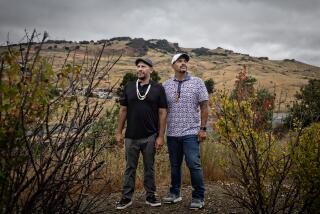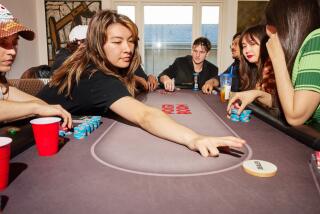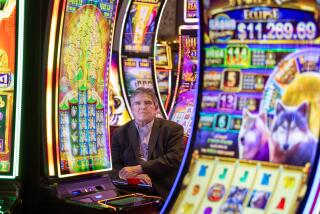Backing the Saddle Again: Council OKs Casino License : Revenue: After a history of stops and starts, the Silver Saddle will get another chance to succeed. Officials are counting on the enterprise to help offset budget woes.
- Share via
CUDAHY — Just when the Southeast area seems inundated with casino proposals, along comes a city with more than a decade of failed casino efforts to make one more try.
Cudahy officials have taken steps to resurrect a casino project that had a history of stops and starts before collapsing more than two years ago when its two partners began feuding.
The City Council voted 3 to 2 recently to approve a new gaming license in hopes of reviving the ill-fated Silver Saddle Casino, which has made several futile attempts since 1982 to open its doors for gaming.
Council members John O. Robertson and Joseph Graffio voted against the new license, arguing that the casino is not a reliable source of income for the financially strapped city.
But other city officials say they are hoping--one more time--that a casino will be able to generate revenues to bolster an anemic city budget.
City officials said they hope to sell the new gaming license to offset a projected $270,000 shortfall in the city’s $3.6-million general fund in the new fiscal year that began Thursday. Officials said they hope to sell the license for at least $500,000.
“It was either this or slashing city staff salaries by 8%,” said City Manager Jack M. Joseph. “And we just didn’t think we could do that to people.”
Revenues from a casino could also bolster the city’s financial condition in future years, Joseph said.
In addition to the $500,000 purchase price, the license holder must make minimum payments of $10,000 a month to the city, plus a percentage of casino’s monthly revenues.
“(The money) would help us bail out of this financial situation,” Mayor Alex F. Rodriguez said. “It’s the only route we can take.”
City officials have counted on casino revenues in the past to bail them out, but were left with nothing but a shell of a casino building and a fiscal headache.
In 1989, city officials had penciled into the budget $400,000 in gaming revenues from the casino. The casino didn’t open, but the city averted a crisis when sales tax revenues exceeded estimates.
The city was not so fortunate in 1990. Officials estimated that the city would receive $650,000 in revenues from the casino, which was scheduled to open in September, 1990, with 100 tables. But the project stalled when Silver Saddle partners Charles R. King and Shyr-Jin Tsay became embroiled in a financial dispute. The city had to sell bonds to offset the lost revenues.
The two former partners found themselves in bankruptcy court, bidding against each other for ownership of the club’s assets.
King, a South Gate real estate broker, bought the Silver Saddle’s gaming license for $1.2 million, outbidding Tsay.
Tsay, a San Marino businessman, gained control of the partially completed casino on Wilcox Avenue and Patata Street in an industrial section of the city. He spent $100,000 on the property and agreed to assume more than $3 million of the project’s past debts. Joseph, the city manager, said Tsay had intended to open a nightclub at the site at some point, with or without the gaming license.
“Each has the missing ingredient that the other one needs for a complete project,” Joseph said. “Because of that, we couldn’t see an acceptable resolution in the near future.”
The city’s solution: Approve a second gaming license in an effort to encourage Tsay to revive the stalled Silver Saddle project.
Joseph said he had contacted Tsay before putting the proposal before the council and learned that Tsay might be interested in buying a new license. “I didn’t want to bring something to council that was just a pie-in-the-sky idea,” said Joseph, aware that council members had grown weary of years of unfulfilled promises on the casino project.
Tsay’s attorney, Kay Kochenderfer, said her client has not yet decided whether he will buy the license, but is considering it.
Some council members remained skeptical.
“It’s wishful thinking,” Graffio said. “We’ve been looking for money from (this project) for years, and it never comes through.”
King’s attorney, Ira G. Rivin, said he is concerned that the new license, which has a minimum price tag of $500,000, would undercut the value of the original gaming license that King had bought for $1.2 million. Rivin declined to comment further. King, a South Gate real estate broker, did not return phone calls.
King first began promoting the gambling effort in 1982, but had trouble lining up financial backers. In 1986 he opened a casino with only four tables in a cramped building that once had been a smog-check station. The casino closed within months.
King and Tsay formed a partnership in 1987, and announced plans to build a 40,000-square-foot gaming hall on the site, with 100 tables.
The city’s effort last month to revive the casino project comes amid of flurry of casino proposals and projects in the area.
A casino has been approved in Compton. Voters in Bellflower and Lynwood will consider card club measures in upcoming elections. A card club proposal in Pico Rivera was narrowly defeated in June, but developers are gearing up for another ballot effort, perhaps as early as next April.
Cudahy voters approved gambling in 1982, Joseph pointed out.
“It’s rather ironic, isn’t it? Casino developers have been spending hundreds of thousands of dollars to get gaming approved in other cities, and we have had the building and the license all along. We just needed to bring them together,” he said.
Key Dates in the Cudahy Casino Saga
December, 1982: A majority of voters approve of card casinos in the city, making Cudahy the sixth city in Los Angeles County to legalize gaming.
July, 1983: Charles King, South Gate real estate agent, announces construction will begin in the fall on a $12-million club.
January, 1984: King asks the City Council for a six-month extension, to July 1, for groundbreaking.
April, 1984: King asks for another extension to complete the land purchase. The council sets a deadline of September, 1985, to have the club operating.
December, 1984: Council gives King permission to scale back his operation from 100 tables to 40 tables.
March, 1985: King buys a 7,000-square-foot cinder-block building on Patata Street that once housed an automobile smog-check station.
February, 1986: The Silver Saddle Casino opens with four gaming tables in a corner of the cramped, box-shaped building. King assures city officials that construction to expand the building will continue.
July, 1986: The club closes.
August, 1986: King files for bankruptcy when a $10,000 check to the city bounces. The city pulls King’s gaming license, but a Bankruptcy Court judge rules that the city cannot revoke the club’s gaming license while King is under Chapter 11 protection.
May, 1987: King tells the council that the project has new financial backing and announces plans to reopen by September.
September, 1987: San Marino businessman Shyr-Jin Tsay teams up with King in a joint venture to finance the Silver Saddle Casino, a new building with 100 tables.
November, 1988: King and Tsay agree to complete construction by January, 1990.
January, 1990: The Silver Saddle Casino’s grand opening is pushed back to September.
September, 1990: With the shell of the building complete, King and Tsay have a financial dispute and declare bankruptcy.
June 10, 1993: King’s $1.2-million bid for the gaming license is approved by the Bankruptcy Court. Tsay buys the casino site for $100,000 and agrees to assume more than $3 million in back debts from the project.
June 24, 1993: Facing a $270,000 budget shortfall, the City Council approves another gaming license. Through his attorney, Tsay expresses interest in buying the new license.
More to Read
Sign up for Essential California
The most important California stories and recommendations in your inbox every morning.
You may occasionally receive promotional content from the Los Angeles Times.










